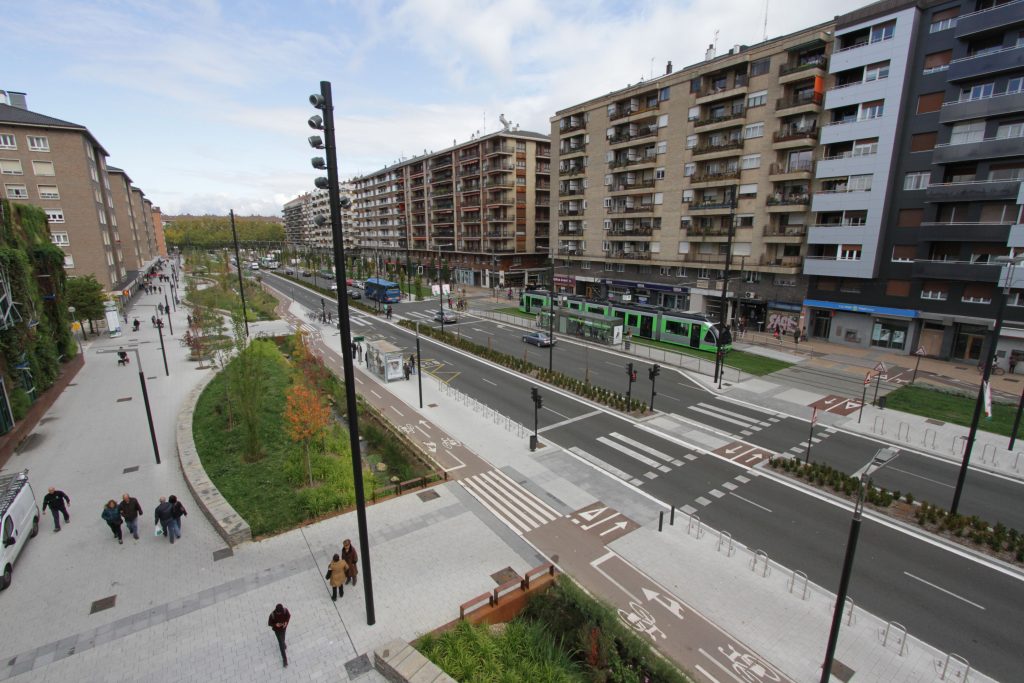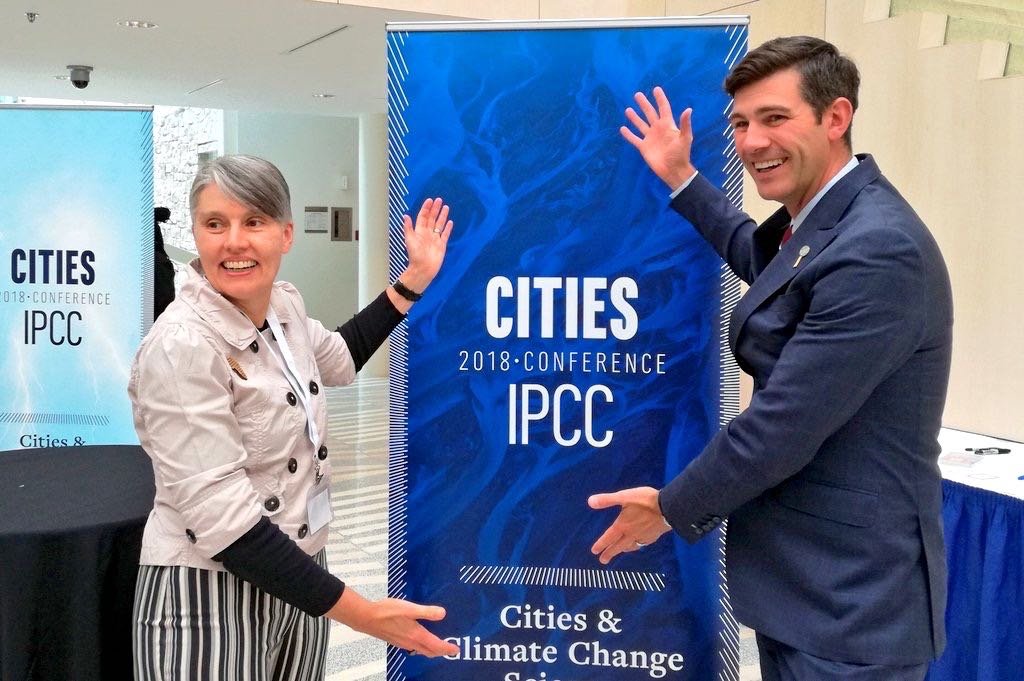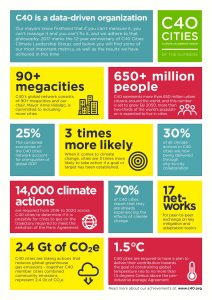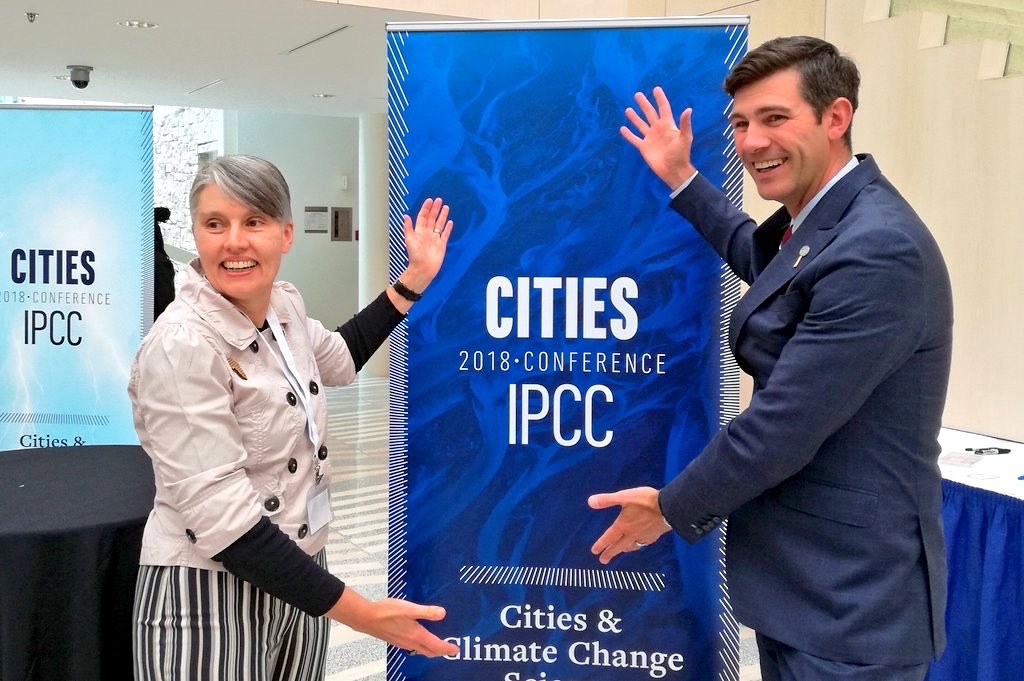By David Dodge and Scott Rollans

Mayor Don Iveson, Andrew Sharman, VP, Facilities and Operations, UofA, Randy Boissonnault (MP), Shaye Anderson (Minister of Municipal Affairs) and Seth Schultz of C40 at the announcement that Edmonton won the bid to host the 2018 Cities and Climate Change Science conference in Edmonton, Alberta. Photo COE
How the heck did Edmonton, Alberta wind up as host to an IPCC international 2018 Cities and Climate Change Science Conference?
This conference is a big deal.
It’s sponsored by the International Panel on Climate Change (IPCC), the very same United Nations organization that hosts the big global Conferences of the Parties (COP)—such as the COP21 in Paris in 2015, COP22 Marrakech in 2016 and later this year in November COP23 in Bonn, Germany.
The story goes something like this: Edmonton’s Mayor Don Iveson was in Marrakech and he sat beside Debra Roberts of Durban, South Africa, who also happens to be Co-chair of the IPCC Working Group II. She encouraged Iveson and Edmonton to bid on the conference and, in May 2017, Edmonton was selected from among ten other bidding cities from around the world.
In September, Roberts and almost a dozen other officials toured Edmonton and began preparations for the conference that will run March 5–7, 2018.
Climate change and cities
Seth Schultz is Director of Science and Innovation with C40 Cities Climate Leadership Group and a member of the steering committee who was here from New York with the organizing committee.
“There’s been an increasing awareness that, in order to tackle climate change, cities have to be a key component in it,” says Schultz.
“If you imagine that 70 per cent of the world’s energy consumption occurs in cities and more than 50 per cent of the world’s population lives in cities … it starts becoming pretty self-evident that, if cities aren’t part of the solution, we’re not going to get there in time.”
Paris was a seminal moment in the history of international climate change negotiations. Up until then, the role of science was mostly to convince nation states of the urgency and the very existence of climate change. Paris marks a transformation from debate to action.
And, once the vast majority of nations committed to action, the attention of science turned to cities, where most of the world emissions originate.
The Paris 2 degree commitment
In the Paris Agreement, nations agreed to limit the temperature increase to 2 degrees Celsius and to strive to limit the increase to 1.5 degrees by dramatically reducing carbon emissions and ultimately by reaching carbon neutrality by 2050. In this case, carbon neutrality means the amount of carbon emitted by humans cannot be more than nature can absorb.
Cities are responsible for “80 per cent of global CO2 emissions,” says Schultz.
The average city in the world emits about nine tonnes per capita.
“We (C40) looked at an aggregate of the emissions associated with cities on a per-capita basis that average ends up [at C40 cities] being about nine tons per person.”
Schultz says that average needs to drop by two thirds, from nine to three tonnes per capita by 2030.
Three tonnes per capita – easy for some, but very hard for others
“You could have a city like Portland Oregon which is anywhere like three tons per person all the way up to cities like Houston or the city of Edmonton are at anywhere from 15 tons per person all the way up to 25 tons per person.”

According to C40, a group of 90 megacities action to reduce emissions must happen in the next few years.
“If you look at the city of Atlanta in the US and the City of Barcelona in Spain those cities have roughly almost the exactly same number of people in them. But the amount of land that Atlanta occupies is four times greater than the amount of land area that the City of Barcelona covers. And the difference between the GHG emissions is three times less in Barcelona.”
So what can you do if you are Edmonton, with per capita emissions of 15 tonnes person?
That’s daunting indeed, but Schultz sees glimmers of hope in Edmonton, such as the city’s plans to double the size of the LRT, build denser transit oriented development, and encourage a downtown where people live, work, and play.
That being said, Edmonton has much to do in its much-touted Energy Transition Plan to reduce emissions. The plan seeks to reduce energy use 25 per cent per capita, slash emissions by 23 per cent, and generate 10 per cent of Edmonton’s clean energy locally.
Schultz’s C40 organization was created by Mayor Ken Livingstone of London, with assistance from former President Bill Clinton (who started the C40 group to help 40 mega cities take action). That group has grown to 90 mega cities and signs of hope are beginning to emerge. Vancouver, Toronto and Montreal are three of the “megacities” in C40.
Growth without carbon?
“There’s a burgeoning body of work … looking at how there is now a trend in decoupling carbon in GHG emissions from economic output.”
“In C40 alone you have over 90 cities, and a third of those, 30 cities, have already got data indicating that even while their populations are still growing, their emissions have plateaued and or are going down—while their economic output has continued to grow along with their city populations.”
Decoupling economic growth from the growth of carbon emissions is the holy grail for decarbonization.
Cities that are making progress are reinventing their urban form. “They’re recapturing the space; they’re making cities, both from the built environment down to the street, more usable for people again. Whereas, predominantly, they were used really to move cars around not people around.”

Vitoria-Gasteiz in Spain once had a 12-lane roadway plowing through the centre of the City. Then planners decided to do what most cities only talk about. They looked at different modes of transportation and gave appropriate space to each, based on their actual use. Gasteiz Avenue was transformed from 12 lanes of traffic and parking to a naturalized multi-mode street supporting a new tram LRT, cycling, pedestrians, a naturalized river and yes cars too. A successful transformation? 54% of all trips are by walking, 12% are by cycling and only 24% are by car today in the capital of the Basque Country in northern Spain. Photo David Dodge, GreenEnergyFutures.ca
Vitoria Gasteiz’s home, in the Basque Country in Spain, is not one of the mega cities, but her city has been amazingly successful at increasing green space. They transformed a 12-lane roadway into a truly multi-mode marvel of design for pedestrians, cyclists, transit users and—yes—even drivers.
China emerging as leader

City councillor Scott McKeen cycling in front of City Hall. Cities need to decarbonize transportation to meet climate change goals.
Even China, once stereotyped as the pariah of progress on climate change, is becoming a world leader in transitioning to new urban forms, increasing clean energy and reducing emissions, Schultz says. This is partly driven by China’s explosive growth—they hit the wall of unsustainability with “congestion to the extent that, in order to drive 100 kilometers, you have to sit in the car for a day. They have levels of outdoor air pollution that is so severe you can’t go outside.” Researchers have estimated life expectancy reductions of up to 5.5 years as a consequence.
“They’re going full tilt at decarbonize themselves. It’s absolutely astounding. We were in Shenzhen a few years ago. And found out that they had 1,300 electric buses. It’s the largest electrical bus fleet in the world.” In 2016 115,700 electric buses were sold in China.
China also leads the world in investment in clean energy, with $102 billion in 2015, and another $360 billion planned by 2020.
Although President Donald Trump appears to be stepping back from commitments, Schultz says, “China is stepping up and pushing this agenda forward and filling the void in terms of global leadership on the agenda of climate change.”
Getting science working to reduce emissions in cities
Cities can also help fill that void, Schultz says. The 2018 Cities and Climate Change Science Conference in Edmonton aims to do its part by bringing climate science and cities together.
“We’re looking to bring together the research, the policy makers and the practitioners—three different stakeholder groups—to come together, and were asking them to develop new processes and mechanisms that they haven’t done before.”
Science leaders, heads of state, and high-level dignitaries from around the world will converge on Edmonton, bringing with them plenty of media attention.

Edmonton builders are leaders in building super energy efficient, net-zero homes. This Landmark home sells for under $400k Cdn and is solar-powered and fully net-zero.
In fact, Edmonton has already made a strong impression, says Schultz. “The leadership that we’ve seen from Mayor Iveson … and the logistical people who are showing us the facilities have just been a class act, unbelievably organized, incredibly professional.
“From the get-go they’ve have understood the vision and ambition for this conference, so we’ve been totally, totally blown away and pleased with how gracious and how competent the City of Edmonton staff have been.
A call for papers for the conference closes on October 10. Expect to see a “Green zone” buzz of activity surrounding the conference when it comes to town next March.



